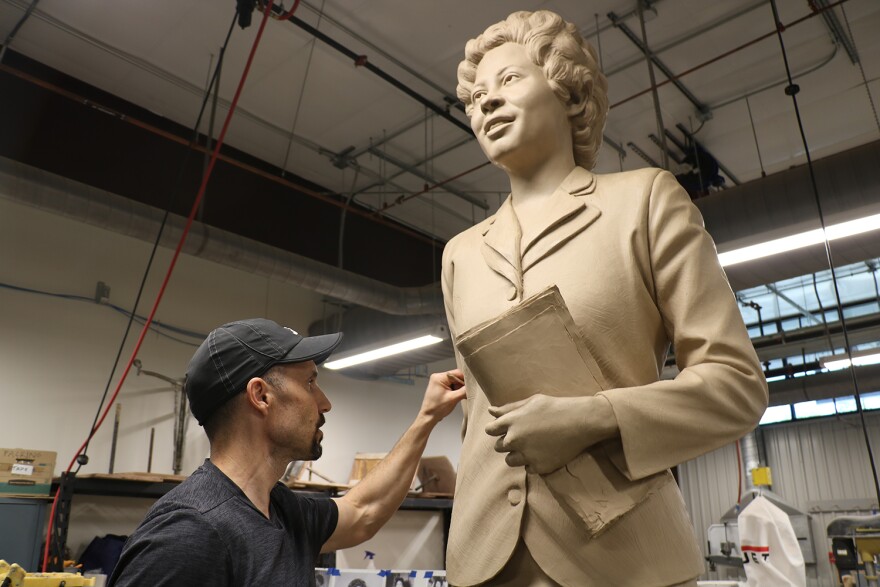Arkansas Gov. Asa Hutchinson on Thursday got his first look at the clay model that will be used to cast a bronze statue of singer Johnny Cash for the U.S. Capitol.
Each state has two statues on display with most in Statuary Hall. The one of Cash and another being made of civil rights leader Daisy Bates will eventually represent Arkansas.
Hutchinson stopped by the University of Arkansas at Little Rock’s Windgate Center of Art and Design where he met with sculptor Kevin Kresse.
“Oh man, you got his face totally, that is so impressive,” Hutchinson told Kresse while walking around the eight-foot tall model.
“What do you think about working on something that's going to be in our nation's Capitol representing our state,” Hutchinson asked Kresse.
“Sometimes it's too big to actually wrap my head around or to think about because I think then I’ll freeze,” Kresse said.
“Well, I can't tell you what it means to me just in the sense of, I've taken Arkansans and other people through our nation's Capitol and I showed them our historical figures and nobody identified with them,” Hutchinson said.
The statues currently representing the state are of attorney Uriah Rose and former governor and U.S. Sen. James P. Clark. Hutchinson had strongly urged state lawmakers during the 2019 legislative session to approve a bill replacing the statues which are more than a century old. There was debate about who the two new statues should feature, with the governor suggesting Cash and Bates.
“To go there and see Johnny Cash from Arkansas, he represents our music heritage, he represents the struggles that we had as a state back in the ‘30s with his parents there, and then, you know, his music came out of the soil of Arkansas. I mean, he represents our history, our culture in so many different ways,” Hutchinson told Kresse. “So, this means a lot to the state of Arkansas.”
The artist responded by telling the governor how proud he was as an Arkansan to have been selected to create the statue. Other finalists considered by the National Statuary Hall Steering Committee were from outside the state.
Last week, Kresse invited the public to see progress on the statue at that point and to watch him work at the Windgate Center. During the extremely hot weather lately, Kresse said he has enjoyed working in the university’s studio because his studio in North Little Rock does not have air conditioning.
Since the public viewing, Kresse has received the clay part that will be the guitar strung around Cash’s back. He had just received the neck of the guitar from a foundry in Oklahoma on Wednesday and Hutchinson was among the first people to see Cash with the guitar.

“It’s looking a little homemade right now,” Kresse said in an interview. The guitar was lacking details like frets that the artist will slowly add until it looks like an exact replica of the high-end Martin D-35 model that Cash played.
“The D-35, you have to know these things,” Kresse said. “99.9% of the people would not know, but that other one, they're going to be going, ‘That’s not a Martin D-35'. So yeah, you have to make sure you get it right.”
In an interview with KUAR News after seeing the clay model of Cash, Hutchinson was asked about his first impression.
“Well, the first thing that strikes you is that it's an enormous project. It's tall, a little bit taller than life-size and I think that will be a powerful presence in the nation's Capitol,” Hutchinson said. “Secondly, of course, the fact that he has his head bowed just a little bit strikes you, and I think it goes to his humbleness and how he had a tough life himself, even though he was a star. But he identified with those people who struggled in life and I think that's why he had such a following and continues that today, the incredible people that love his music and respect his life.”
Hutchinson said he was also moved by the Bible in Cash’s right hand. Faith had always been important to Cash who enjoyed recording and performing gospel songs during his concerts, even those held in prisons.
“The gospel songs that he grew up with, that was a big part of his music heritage, and of course that means a lot to me because I grew up in a small church that had the gospel hymns and actually probably in some ways similar to his upbringing in the church,” Hutchinson said. “In this day and time I think that's refreshing to be able to have that representation of faith in our nation's Capitol.”
There was extensive debate in the legislature in 2019 about who would best represent the state. Some lawmakers suggested someone like Sam Walton, founder of Arkansas-based retail giant Walmart, would be a better role model. Hutchinson pushed for Cash and Bates.
Bates was best known for mentoring the nine Black students who desegregated Little Rock’s Central High School in 1957. She and husband L.C. Bates also published the Arkansas State Press newspaper.

Hutchinson suggested Thursday the final choices of who to place in the Capitol are a good balance.
“Daisy Gatson Bates, obviously as a civil rights icon, is such a great representative for Arkansas, both the struggles of the past but our hopes for the future,” he said. “Johnny Cash brings a little bit lighter tone to it in some ways, but it also reflects the seriousness of life, the struggles of life, and so there's a little commonality between these two historic figures that will be representing Arkansas. You can tell a story about Arkansas through each of these figures that will be meaningful to the people that visit the Capitol.”







